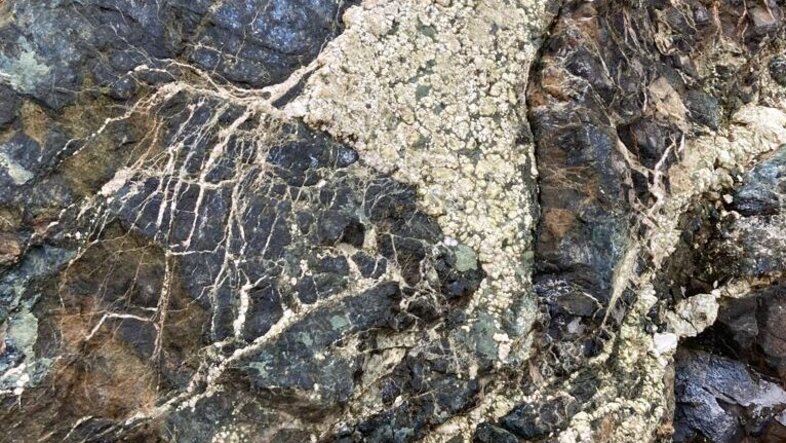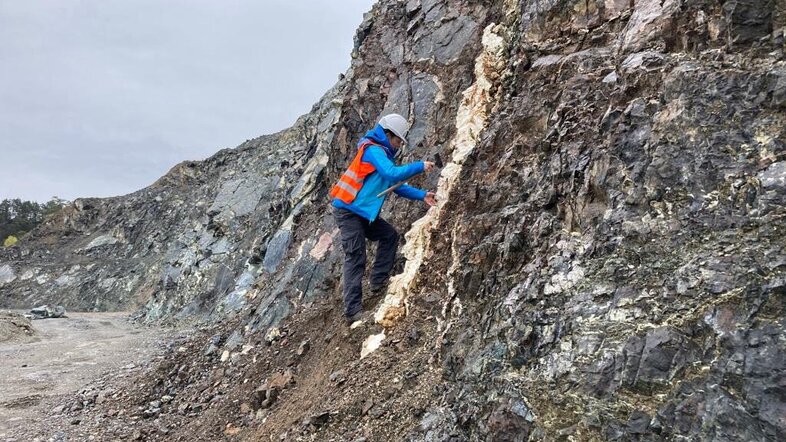Archaea as climate saviours?
Our Earth is constantly moving: Tectonic forces can swallow an entire sea and spew whole mountains. This will also happen to our Mediterranean Sea in the remote future and this way, approximately 400 million years ago, ancient rocks of the Kraubath deposit in Styria came to life through the formation of the Alps.
In the office at UZA II of the University of Vienna, the geologist Jennifer Zwicker is turning a rock covered by magnesite veins from the Kraubath deposit in her hands. She chipped off the stone with a hammer and sawed it up into individual parts. How exactly the magnesite that is usually of hydrothermal origin comes to the Eastern Alps and whether the underlying mechanisms could help us combat the climate crisis is the subject of the young scientist’s current research project.
Formation of magnesite at the sea floor
Where the tectonic plates are drifting apart, dissolved material is spilling from the Earth's interior. These so-called spreading zones are often found at the sea floor, says Jennifer Zwicker. If Earth material is rising slowly enough with high temperatures and the chemical composition is appropriate, peridotite is formed. In contact with water, peridotite is converted to serpentine, which is the 'construction material of magnesite'.
Serpentinisation – this is what mineralogists call the process of mineral conversion – is also occurring on shore under low temperatures. "Magnesite is also being formed if ground water is circulating in continental seabed rock. This can happen in very saline lakes or in some alkaline springs, but also in the Kraubath magnesite deposit in Styria," explains the geologist.
The mystery surrounding the magnesite in Styria
Magnesite formation in the Eastern Alps still presents some mystery to research. A relatively recent explanation for it, which is also put forward by Jennifer Zwicker, emphasises the influence of very tiny archaea, i.e. organisms that, in addition to bacteria and eukaryotes, are the third domain of life, "A solution becomes a solid body if the thermodynamic conditions are suitable. But sometimes these are absolutely not suitable and we, nevertheless, find magnesite. On land, rock is serpentinised by rainwater, resulting in the formation of hydrogen, which archaea can use for their metabolism. In this process, archaea are producing energy. As a side product, new solids, such as magnesite can form."
Archaea vs bacteria
Archaea, in addition to bacteria and eukaryotes are forming the third domain of life. They are the only organisms we know of that can produce methane. The main characteristic of archaea, differentiating them from bacteria, is their membrane which is extremely robust. This makes them true survivalists and they feel comfortable even when being exposed to extreme temperatures: in the volcanic landscapes of Iceland, at temperatures above 110 degrees Celsius or, rather moderate, in the garden of the UZA II of the University of Vienna.
Archaea as key organisms
Jennifer Zwicker and her colleagues already found archaea baked as molecular fossils in similar environments in Turkey. For the Kraubath magnesite deposit, they are still looking for the powerful evidence highlighting the key role of archaea in magnesite formation.
To find this evidence, the mineralogists is analysing rock samples from Kraubath on the one hand, and she is cultivating archaea under Kraubath conditions in the laboratory, on the other. As a first step, the researcher has studied the basics of microbiology and had to spend a lot of time in the white lab coat, “As a geologist, I usually focus on inorganic chemistry and physical processes, but the link to microbiology can shed new light on the matter.”
Getting Kraubath rock into the laboratory
In the laboratory, the usually very frugal archaea are becoming extremely demanding. “They need the correct pH value and the perfect temperature range, otherwise, the cultures die,” Jennifer Zwicker explains. With this project, she is approaching the emerging discipline of geomicrobiology for the first time, “This can be quite frustrating sometimes”. Nevertheless, the committed scientist has never thought about giving up because the processes in the close Eastern Alps are “far too exciting”.
Archaea as climate saviours?
Magnesite deposits are actually a hot topic in geology, not only because magnesite is extremely heat resistant and thus needed as fire-proof material for the production of blast furnaces and similar products. Magnesite (MgCO3) largely consists of carbon and its deposits are at a premium as storage site for carbon dioxide. The greenhouse gas from the atmosphere is thus rendered harmless as a solid. And if archaea are actually responsible for this, these microorganisms can also be used for the protection of the climate in the long term. However, before they can be used in an industrial process, several questions need to be answered. Nevertheless, Jennifer Zwicker is leaving no (magnesite) stone unturned in her basic research which provides the basis for future research on this issue. (hm)

